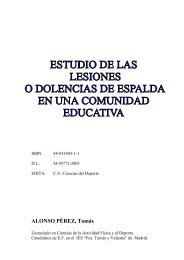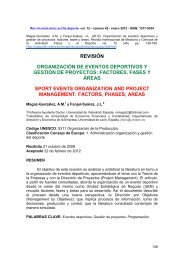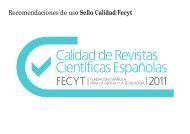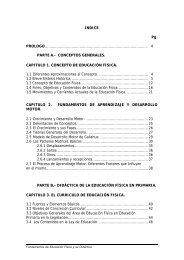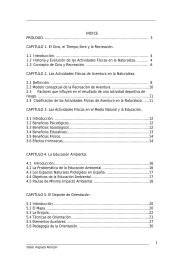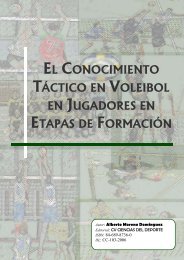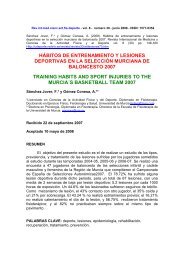La formación inicial para una Educación Física inclusiva
La formación inicial para una Educación Física inclusiva
La formación inicial para una Educación Física inclusiva
Create successful ePaper yourself
Turn your PDF publications into a flip-book with our unique Google optimized e-Paper software.
Rev.int.med.cienc.act.fís.deporte- vol.x - número x - ISSN: 1577-0354<br />
componente actitudinal, aunque se detecta falta de concreción sobre cuáles<br />
serían todos los ingredientes fundamentales de un perfil competencial del<br />
docente de EF que enseña AFA.<br />
PALABRAS CLAVE: <strong>Educación</strong> <strong>Física</strong>; Actividad <strong>Física</strong> Adaptada (AFA);<br />
Formación Inicial de Grado; Competencias.<br />
ABSTRACT<br />
The purpose of the present study was to analyze the situation of the initial<br />
teacher training, and the framework for reaching a consensus on a<br />
competences profile in the training of professionals of adapted physical activity<br />
(APE). With the use of an interpreting method, non-participant observation and<br />
interviews were used. Seven prestigious and linked to the University experts in<br />
AFA and FI participated in the study, and we attended a National Convention of<br />
experts that discussed issues related to the purpose of the study. The experts’<br />
speeches were analyzed in its content, with the orientation of the previously<br />
defined categories. The analysis allows us to conclude that the judgments of<br />
value on the FI are mediated by the perceptions of concrete realities. Experts<br />
identify basic elements for a profile of competences, with a strong behavioral<br />
component, although we detect lack of precision about what would be the key<br />
ingredients of a competence profile for the training of the professional of PE that<br />
teaches AFA.<br />
KEY WORDS: Physical Education (PE), Adapted Physical Education (APE),<br />
Initial Teacher Training, Competences, Inclusion.<br />
1. INTRODUCCIÓN<br />
En 1994, auspiciada por la UNESCO, se celebró en Salamanca (España)<br />
la Conferencia Mundial sobre Necesidades Educativas Especiales: Acceso y<br />
Calidad. De dicha Conferencia surgen dos documentos de gran relevancia <strong>para</strong><br />
la educación y <strong>para</strong> las personas con discapacidad. Como señala Saleh (2004),<br />
ambos documentos, la Declaración de Salamanca y el Marco de Acción,<br />
“constituyen el evento clave que hoy otorga confianza y firmeza global a la<br />
tarea de situar la cuestión de “la inclusión” en la agenda mundial” (p. 27).<br />
A partir de entonces, las declaraciones institucionales, informes, normas y<br />
recomendaciones reflejan el avance social y cultural que ha experimentado el<br />
reconocimiento de los derechos de las personas con discapacidad. En ese<br />
marco institucional de referencia a las políticas de inclusión, las actividades<br />
físico-deportivas y recreativas no han quedado al margen y así se reconoce,<br />
por ejemplo, en el “Instrumento de Ratificación de la Convención sobre los<br />
Derechos de las Personas con Discapacidad, hecho en Nueva York el 13 de<br />
diciembre de 2006”, aprobado por el Estado Español en 2008 (BOE, 2008). En<br />
dicha ratificación de la Convención de Naciones Unidas, el Estado Español<br />
2



